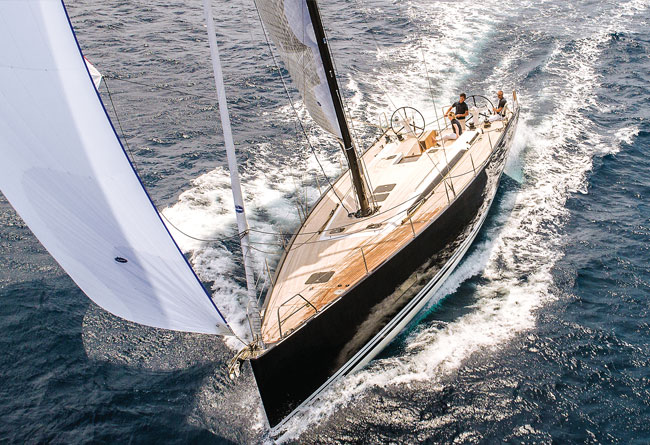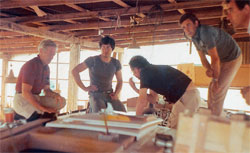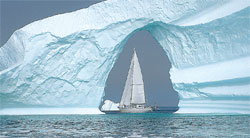

When the Solaris team applied their 44 years of high-end boatbuilding experience to upping the game in the mid-sized performance cruiser market the result was something rather special… Italian, of course!
Looks good, doesn’t she? Easy on the eye. It’s difficult to know exactly why but she just looks… right. A sort of understated elegance that whispers style, comfort and control, while at the same time suggesting performance, an unspoken promise of power. The new Solaris 55 was developed by Solaris Yachts’ in-house technical team with naval architecture input from Argentinian designer Javier Soto Acebal.
Since being founded in 1974 in Aquileia, moments from the lagoons of Venice, the Solaris shipyard has successfully mastered the blend of studied, elegant comfort with the sort of performance that reminds us that it’s good to be alive and here at the wheel. In its long story Solaris has worked with many top designers including the late Franz Maas, Sparkman & Stephens, Doug Peterson, Bill Tripp and now Soto Acebal.
One of the other designs currently in build at Solaris is a new light-displacement Maxi72-styled Wally 93, which also perhaps explains some visible aesthetic parallels between the two houses.
The Italian yard is now among the biggest composite production facilities in Europe and to date has produced over 200 yachts between 37 and 68ft. An impressive range of manufacturing equipment includes an oven of up to 130ft – Solaris has completed several carbon luxury yachts of between 80 and 120ft.
This company also understands that its loyal owners want the ability to sail shorthanded, or with family and friends who are perhaps not seasoned sailors. To that end, all the sail controls on the new 55 are kept within reach of the two wheels and there’s an optional self-tacking jib to make upwind sailing as stress-free as possible. A simple, but effective, sailing package was at the heart of the team’s latest brief – while respecting the Solaris lineage in terms of performance and aesthetics.
The brief for each new Solaris model usually begins with just a displacement figure and an LOA, with which the design team then start to work out how much of the displacement can end up below the waterline in the search for the optimal hull shape.
For the new 55 the designers opted early on for a high prismatic coefficient, with generous hull volume fore and aft to avoid the need for excessive width midships to meet form stability targets. Some flare was then incorporated in the upper bow sections for reserve buoyancy, the flare carrying aft to increase interior volume. One drawback with hull flare can be the increase in wetted surface with heel, but with so much form stability the designers could recover any losses by reducing the keel weight for the same stability with a commensurate reduction in displacement.
With such a powerful hull, twin rudders were considered essential, resulting in a yacht that is easy to steer and, importantly, that is also kind in terms of power demand when under autopilot. With the light helm the team also dispensed with a main traveller – safer for the uninitiated guest and freeing up considerable cockpit space.
The boat demonstrates a distinctly modern appearance and the team feel they have set some new benchmarks in terms of both performance and styling with their latest baby. A contemporary reverse bow is nicely balanced by the aggressive vertical transom, with rig and appendages – including the dramatic forwardraked keel fin – positioned notably far aft for a boat of this type.
 Above: not your typical production yard… this is the hull of the new all-carbon lightweight Wally 93 emerging from the split mould at Solaris last year, and (below) a step back in the history of this Italian builder as Rod Stephens (at left) oversees the detailed deck design for the 1979 IOR Two Tonner Rupe. And then for something a little different at the other end of the spectrum (bottom): this is the Doug Peterson designed Solaris 72 Kamana which recently completed a global circumnavigation via the Northwest Passage
Above: not your typical production yard… this is the hull of the new all-carbon lightweight Wally 93 emerging from the split mould at Solaris last year, and (below) a step back in the history of this Italian builder as Rod Stephens (at left) oversees the detailed deck design for the 1979 IOR Two Tonner Rupe. And then for something a little different at the other end of the spectrum (bottom): this is the Doug Peterson designed Solaris 72 Kamana which recently completed a global circumnavigation via the Northwest Passage

One reason for this aft set rig/appendage package is to allow the larger genoas that Acebal and the Solaris team favour for designs where there is a focus on good performance without too much sail changing. Add to that mix plenty of stowage on deck and below, because Solaris owners like their toys and their luxuries, and you’ve got a fairly compelling performance cruising package.
In all of the yachts it builds Solaris makes full use of its access to relatively specialised construction methods at its long established yard. Over 44 years these methods have become tried, refined and well tested. This is why Solaris can seemingly make quite bold construction choices with confidence for the end product.
One example of this is an above-average use of composites for a yacht of this type with composite/metallic bonds and mechanical connections kept to the minimum. All Solaris chainplates are now composite – one reason being to minimise mixing materials with different mechanical properties that will inevitably ‘work’ differently under load.
All transverse and longitudinal floors are externally laminated and cured before being bonded into the hull with intersections reinforced using unidirectional fibres, creating a hugely strong primary structure. In fact, unidirectional fibres are used extensively throughout the Solaris range, especially in high load areas around the keel floors, mast step, rudder posts and chainplates. By carefully linking key load areas and employing robust 40mm foam-cored bulkheads and similarly light, but strong interior panels, the yard creates a single laminate structure of enormous strength; in terms of torsional and global rigidity the resulting deflections are more typical of a large racing yacht (though rather more robust and durable…).
Acebal himself is pleased with this collaboration… ‘I sailed the standard boat in Varazze and we’re very happy with her, she’s really fast for a luxury cruiser with this level of onboard comforts. Of course there are clients who want even more power, so we have regatta options including a different keel, carbon rudders, a lighter carbon transom door, different sail dimensions and so on!
‘When you combine all those elements in one simple, elegant boat, the result can be very pleasant…’
It’s clear that even after 44 years Solaris remains determined to go its own way. This Italian shipyard always backs itself and likes to do things just a little differently. Amen to that.
Click here for more information on Solaris Yachts »
We invite you to read on and find out for yourself why Seahorse is the most highly-rated source in the world for anyone who is serious about their racing.
To read on simply SIGN up NOW
Take advantage of our very best subscription offer or order a single copy of this issue of Seahorse.
Online at:
www.seahorse.co.uk/shop and use the code TECH20
Or for iPad simply download the Seahorse App at the iTunes store


